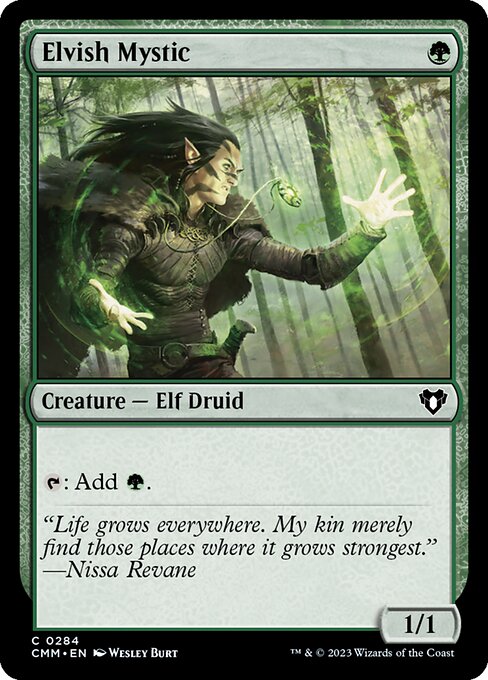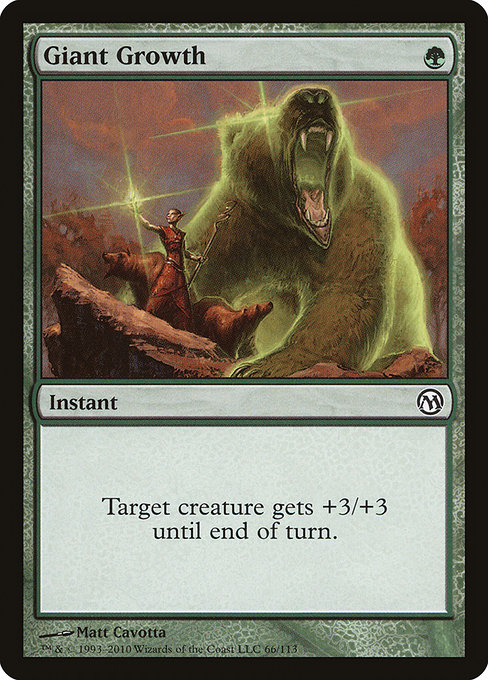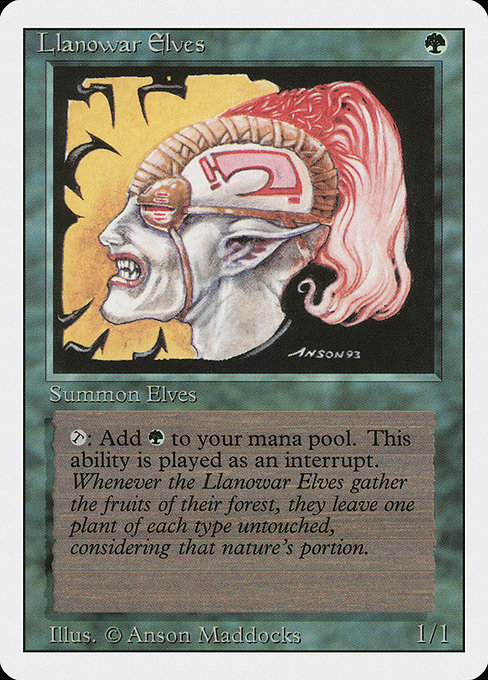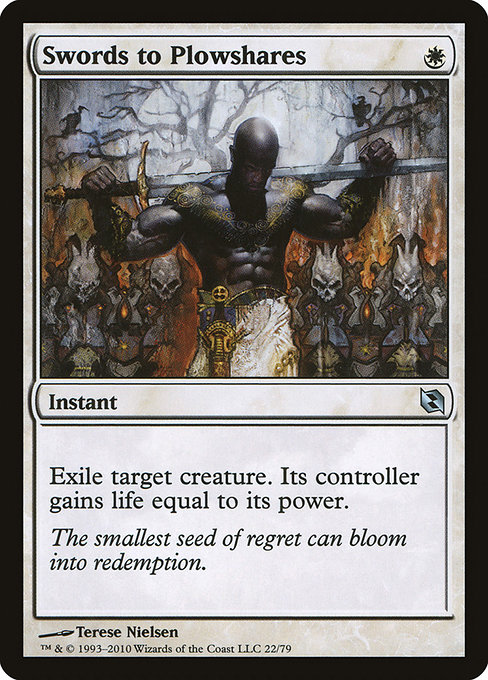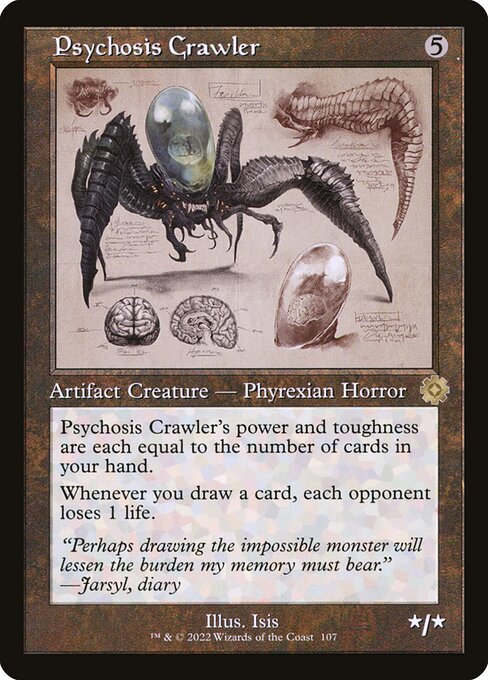
Psychosis Crawler

Guide Sections
Strategy Guide
Last updated 2025-07-06Quick Summary
Psychosis Crawler is a {5}-mana Artifact Creature — Phyrexian Horror with a power and toughness equal to the number of cards in your hand. This means its stats are completely dynamic and change with every card drawn or discarded. An empty hand results in a 0/0 creature, while a seven-card hand yields a formidable 7/7. Note that this power and toughness are recalculated continuously, meaning effects that change your hand size (such as Serum Visions) will immediately affect the Crawler's stats. If the Crawler's toughness is reduced to 0, it will die.
The Crawler's other ability triggers whenever you draw a card: each opponent loses 1 life. This life loss is not dependent on the Crawler being on the battlefield; as long as the Crawler is under your control, drawing a card will trigger this effect. This effect can be quite potent in conjunction with card draw engines such as Mystic Remora or Rhystic Study, creating a significant drain on your opponents' life totals. Consider that effects which cause you to draw multiple cards in a single instance, such as Wheel of Fortune, will cause each opponent to lose life for each card drawn.
Edge cases include situations where the Crawler's toughness is reduced to 0 before its power is calculated, resulting in its immediate death. For example, if an opponent casts Doom Blade targeting the Crawler while you have zero cards in hand, the Crawler will be a 0/0 and die before its power can be calculated. Similarly, effects that temporarily reduce the Crawler's toughness (such as Pacifism) will alter its survival prospects. The interaction with effects that alter your hand size, but not through drawing cards, like Brainstorm is important to note: it changes the Crawler's power and toughness but doesn't trigger the life loss ability.
Psychosis Crawler is a powerful, hand-size-dependent threat that excels in strategies focused on manipulating hand size and drawing cards. Its power and toughness are directly tied to the number of cards in your hand, making it a surprisingly resilient and potentially overwhelming attacker or blocker. Decks that leverage card draw and hand manipulation will find Psychosis Crawler highly synergistic.
Archetypes that benefit most include those employing strategies to maintain a consistently large hand size. For instance, Coiling Oracle or Mystic Remora can significantly inflate the Crawler's stats while simultaneously impacting the opponent's resource management. Similarly, decks using effects that benefit from drawing cards, such as Rhystic Study, will find its life drain effect an added bonus that complements the card draw engine. Psychosis Crawler's cost of {5} isn't insignificant, but its potential payoff, especially in the late game, makes it a worthwhile inclusion.
The card fills several roles depending on the deck's strategy:
- Win Condition: In decks with enough card draw, Psychosis Crawler can quickly become an insurmountable threat, capable of winning the game on its own.
- Value Engine: The life drain triggered by drawing cards offers consistent chip damage alongside the Crawler’s potential as a strong attacker or blocker. This passive pressure can be significant over time.
- Threat: Simply existing with a healthy hand size creates an immediate board presence forcing opponents to dedicate removal or resources to addressing the threat.
In short, Psychosis Crawler rewards consistent card draw and hand management, providing both significant power on the battlefield and a steady stream of life loss for opponents. Successful deployment hinges on maintaining a large hand size and leveraging synergistic card draw effects.
Psychosis Crawler is a powerful engine that leverages hand size to generate both significant power/toughness and life drain. Effective deckbuilding revolves around maximizing the number of cards in your hand while enabling consistent card draw. This creates a positive feedback loop: more cards mean a larger, more threatening Crawler and increased life drain for your opponents. Strategies should prioritize card draw over efficient mana curves, as the Crawler's effectiveness directly correlates with your hand size.
Several card draw engines synergize exceptionally well. Rhystic Study and Mystic Remora provide card advantage while simultaneously punishing opponents for casting spells. Wheel of Fortune effects like Windfall or Rewind can drastically inflate your hand size, resulting in an enormous and immediately lethal Psychosis Crawler, though this does come with the risk of handing your opponent cards as well. However, the life loss from the Crawler itself mitigates this to some extent.
Cards that help you maintain a larger hand size without drawing extra cards are also beneficial. Ancestral Vision and Future Sight allow you to look ahead and plan your draws, enabling strategic hand management. Library of Alexandria provides consistent card draw over time without sacrificing any cards in your hand.
Finally, consider protection. Since Psychosis Crawler is your primary win condition, it's crucial to protect it. Swiftfoot Boots or Lightning Greaves provide haste and hexproof, enabling you to utilize the Crawler's immediate impact. Disenchant effects can deal with problematic removal spells targeting your Crawler. While relying on a single card is risky, the payoff makes it worthy of inclusion in many strategies.
Psychosis Crawler's viability hinges entirely on its hand size, making it highly format-dependent. In formats with consistent hand manipulation and card draw, it can be a powerful threat. However, in formats where maintaining a large hand is difficult or actively detrimental, it will underperform.
In Standard, Psychosis Crawler's success is questionable. While cards like Drawn to the Deep can help inflate hand size, maintaining a consistently large hand while also playing a proactive game is challenging. The life drain is a nice bonus, but is unlikely to be a game-winning factor on its own. Its high mana cost also makes it vulnerable to removal before it can become a significant threat. Overall, Standard is likely too fast for it to be effective.
Historic's greater card pool offers more opportunities. Combining Psychosis Crawler with powerful draw engines like Rielle, the Everwise or Expansion // Explosion could create a potent engine. The increased card pool also allows for more consistent interaction with hand size, mitigating some of the inherent risks. However, even here, the five-mana cost remains a significant hurdle, and the vulnerability to removal remains a key concern.
Commander is where Psychosis Crawler truly shines. The format's focus on high card counts and synergistic strategies makes it an excellent fit. Decks focused on drawing cards, such as those employing Rhystic Study or Mystic Remora, can easily fuel its power and toughness, turning it into a massive, game-ending threat quickly. The life drain adds significant pressure, acting as a secondary win condition. Its vulnerability to board wipes remains a concern, but its potential for explosive growth makes it a formidable inclusion.
Psychosis Crawler excels in strategies that involve manipulating hand size. One impactful scenario arises when playing a control deck. Imagine a late-game board state where you've already established a strong defensive presence with Counterspell and Dovin's Veto. You've carefully thinned your hand to five powerful cards, including Wrath of God and Ugin, the Spirit Dragon. Psychosis Crawler enters the battlefield as a formidable 5/5 creature, immediately applying pressure while simultaneously acting as a life drain engine. Drawing a card with Mystic Remora or simply through normal gameplay further punishes opponents, potentially winning the game through incremental life loss.
Another powerful scenario involves a hand-buffing strategy. If you've played cards like Underworld Breach and Wheel of Fortune to cycle through your deck, you might have a hand brimming with cards. With a hand of, say, eight cards, Psychosis Crawler becomes an 8/8 behemoth, capable of swinging for lethal damage or acting as an unbeatable blocker. The card draw triggers from the Crawler itself further fuel your hand size, creating a positive feedback loop where every card drawn increases its power and simultaneously damages your opponents.
Finally, even in a less optimized hand-size strategy, the Crawler's life drain ability remains relevant. Imagine a mid-game situation where you're slightly behind on life total but have a solid board position with creatures like Walking Ballista. Playing Psychosis Crawler alongside a card draw spell such as Harmonize not only adds a powerful creature to your battlefield but also serves as a crucial life swing, potentially turning the tide of the game by draining your opponents while replenishing your hand.
Psychosis Crawler, a {5} colorless Artifact Creature — Phyrexian Horror from the Battle for Zendikar (brr) set, has carved a unique niche in Magic: The Gathering's history. Its power and toughness are dynamically tied to the number of cards in a player's hand, creating a compelling risk-reward dynamic. Initially, its rarity made it a less frequently seen card in casual play, but its inherent power quickly gained the attention of competitive players. Its ability to become a massive threat quickly, particularly in strategies focused on card advantage, made it a surprising force in various formats. The drawback, however, is the vulnerability inherent in having a large hand; discarding cards to maintain board presence, or being forced to discard by effects like Wrath of God, severely weakens the Crawler.
Reprintings of Psychosis Crawler have been relatively infrequent, highlighting its unique design and perceived power level. This rarity enhances its value in older formats like Commander, where its ability to grow substantially with a well-stocked hand makes it a formidable threat. Unlike many powerful cards that see frequent reprints across various sets, Psychosis Crawler’s limited appearances only serve to emphasize its status as a desirable and somewhat exclusive card. This scarcity contributes to its ongoing collector's value.
The card’s impact on the game has been significant, mostly within specific deck archetypes. It became a crucial component of various control and combo decks that thrived on card advantage. The life drain triggered upon drawing a card synergizes well with strategies aiming to slowly grind down opponents. Cards like Rhystic Study and Mystic Remora enhanced its effectiveness by generating further card advantage while simultaneously increasing its power and toughness and draining the opponent’s life total. This synergy demonstrated that Psychosis Crawler wasn’t merely a powerful creature but also a key piece in a larger strategic puzzle. However, its reliance on a full hand makes it susceptible to disruption. Cards like Thoughtseize and Inquisition of Kozilek present a major challenge to Psychosis Crawler strategies. This inherent fragility balanced its powerful potential, preventing it from dominating the metagame completely.
Psychosis Crawler's design effectively captures the chaotic and parasitic nature of Phyrexia. The flavor text, while absent, is strongly implied by its ability: the more you draw, the more powerful it becomes, mirroring Phyrexia's relentless growth and consumption. The card's power and toughness tied directly to hand size creates a compelling risk/reward mechanic. Holding a large hand fuels its strength, but also makes you vulnerable to card draw effects. This perfectly encapsulates the theme of dangerous, all-consuming power that is characteristic of Phyrexian entities. The art, assuming it depicts a grotesque, rapidly growing horror fueled by its host's actions, would further cement this idea, echoing the unsettling imagery found on cards like Sheoldred, the Apocalypse and Urabrask, Heretic Praetor.
The "whenever you draw a card, each opponent loses 1 life" clause neatly fits the parasitic nature of Phyrexia. This feels like a Phyrexian tax, a life drain that pays off the cost of empowering the Crawler. It directly contrasts with cards that incentivize drawing cards, making strategic deck construction crucial. This effect subtly pushes the player towards a more aggressive playstyle, mirroring Phyrexia's aggressive assimilation tactics. The high mana cost of {5} balances its potentially overwhelming power, preventing it from being a consistently early-game threat. Unlike other powerful Phyrexian creatures, like Yawgmoth, Thrice Dead God, this card has a more dynamic power level that changes constantly. This adds a layer of strategic depth missing from other, statically powerful Phyrexian threats. The card's rarity as a Rare appropriately reflects its unique mechanics and the significant impact it can have on a game.
The budget-friendliness of Psychosis Crawler depends heavily on the context of your deck and your collection. A five-mana cost is relatively high for a creature, especially one whose power and toughness are variable and dependent on the number of cards in your hand. While the card offers potential for significant power and life drain, its effectiveness is directly tied to your hand size, making it potentially unreliable in the early game or against aggressive strategies that disrupt your hand.
Cheaper alternatives exist that offer similar effects, albeit often with less raw power or a different approach. For direct life drain, cards like Torpor Orb or Liliana of the Veil can be effective options (though they offer life drain in different ways), and many other cards offer life-drain abilities at different mana costs. If the goal is a powerful creature with variable stats, consider Walking Ballista which scales with mana spent, although it's not directly tied to hand size. Similarly, many other creatures provide impactful effects without having a massive mana cost and fluctuating power and toughness. The best alternative will ultimately depend on the specific strategy and budget of your deck. Budget-conscious players might explore less expensive options offering similar effects rather than prioritizing this high-cost, variable-power card.
Psychosis Crawler's power and toughness scaling with hand size offers interesting strategic applications beyond straightforward aggressive strategies. While its inherent fragility makes it vulnerable to removal, its potential for explosive growth allows for several nuanced plays. For example, a hand packed with cheap cantrips like Serum Visions or Opt can quickly inflate its power and toughness, creating a surprising threat that quickly overwhelms opponents before they can respond effectively. This tactic is particularly effective when combined with other draw effects, maximizing both the Crawler's stats and the life drain trigger.
The life drain trigger synergizes remarkably well with strategies focused on slowly bleeding opponents out. In decks lacking a significant aggressive element, the Crawler acts as a consistent source of life loss, complementing other attrition strategies. Cards like Torpor Orb can be surprisingly effective against Psychosis Crawler decks, temporarily neutralizing the life drain to allow opponents to recover. Understanding this interaction is key to navigating matchups against the Crawler.
Holding a full hand can make Psychosis Crawler an incredibly powerful finisher, but it also makes you vulnerable to discard effects. Careful hand management becomes critical; you need to balance the desire for a large Crawler with the necessity of retaining key spells or land. Thoughtseize and Inquisition of Kozilek become serious threats, forcing careful consideration of which cards to keep and which to discard. This careful balance between maintaining a large hand and protecting vital cards introduces a unique layer of complexity to gameplay.
Common Mistakes with Psychosis Crawler often stem from a misunderstanding of its power and toughness being directly tied to hand size, and the life loss triggered by drawing cards.
One prevalent mistake is overextending early. Because the Crawler's power and toughness are variable, players might overestimate its strength, committing it to combat before having enough cards in hand to ensure its survival. This is especially true against removal spells like Path to Exile or Doom Blade. It's crucial to wait until you have a sufficient hand size to make it a real threat before sending it into the red zone.
Another common error involves card draw management. While the life drain on draws is beneficial, recklessly drawing cards can backfire. Drawing cards to boost Psychosis Crawler's size can leave you vulnerable to hand disruption like Thoughtseize or Inquisition of Kozilek. A balanced approach, carefully considering the trade-off between Crawler size and hand size, is necessary. Players might inadvertently draw themselves into a situation where they have a massive Crawler but no cards left to defend it or continue the game.
Finally, some players fail to account for the interaction between Psychosis Crawler and other effects that modify hand size. Cards that mill you, like Jace, Vryn's Prodigy or Liliana of the Veil, directly affect the Crawler’s power and toughness. Similarly, effects that reduce your hand size will weaken it. Conversely, cards like Mystic Remora synergize incredibly well, further powering the Crawler while simultaneously draining opponents’ lives. Failing to consider these interactions can lead to unexpected and unfavorable outcomes.
Psychosis Crawler is a powerful engine that scales directly with the size of your hand. Its power and toughness are determined by the number of cards you hold, meaning it quickly becomes a significant threat. The life drain triggered on each card draw provides a potent supplementary effect, acting as incremental removal against opponents. This makes it a highly effective win condition in strategies focused on card draw, synergizing particularly well with cards like Rhystic Study and Mystic Remora that reward you for drawing cards. However, its high mana cost necessitates a deck capable of ramping into it and maintaining a consistently large hand size to maximize its impact. Playing Psychosis Crawler too early risks a small and ineffective creature. It's best deployed when you have a substantial hand and can protect it from removal. Its vulnerability to board wipes is a key weakness to consider, emphasizing the importance of hand size and a balanced game plan that can recover quickly.

